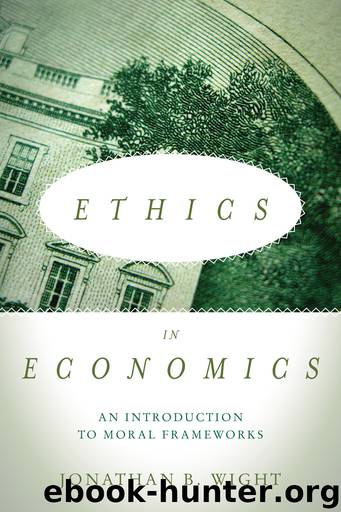Ethics in Economics by Wight Jonathan B

Author:Wight, Jonathan B. [Wight, Jonathan B.]
Language: eng
Format: epub
Publisher: Stanford University Press
Published: 2015-11-22T16:00:00+00:00
CHAPTER 9
Ethics and the Financial Crisis of 2008
This chapter explores ethical beliefs that contributed to financial deregulation and the global financial crisis of 2008. Proponents of laissez-faire markets argue that greed produces self-regulation and sufficient safety, presumably based on Adam Smith’s notion of an invisible hand. This turns out to misrepresent Smith and his ethical-economic model. To Smith, human instincts need to be channeled through appropriate institutions; in his model, regulations in financial markets are warranted.
INTRODUCTION
A financial panic originating on Wall Street led to a worldwide economic downturn in 2008. Wealth in the United States shrank by $16 trillion, about one-quarter of total wealth. More than 16 million households experienced a mortgage loan foreclosure between 2006 and 2012, and more than 5 million households were evicted from their homes. Although the crisis began in the United States, many other countries fared far worse. The causes and consequences of this event are complex and controversial, admitting of no single perspective.1 The deregulation of financial markets after 1980 played a part by creating a more fragile financial system. The pooling of mortgage assets was intended to hedge risk but actually served to amplify risks that were systemic and poorly understood. The rollback of regulations had a strong moral and ideological premise that greed is good and that greed leads to adequate self-regulation in the market. High risk taking through financial innovation soon replaced the stodgy products and services mandated after the collapse of the Great Depression.
The Morality of Keynesian Economics
The Great Depression was a searing event in economic history. A quarter of the labor force in the United States became unemployed in the dark year of 1933. The suffering was recorded in Dorothea Lange’s photojournalism and in epic novels such as John Steinbeck’s The Grapes of Wrath (1939). What makes that episode so tragic is that many economists came to see the severity of the depression as largely avoidable. Better policies and regulations by the monetary authorities at the Federal Reserve Board might have reduced runs on banks and prevented contagion effects, so that the downfall of one bank would not produce a systemwide collapse. Appropriate taxing and spending by the federal government could also have provided countercyclical balance in the macro economy. These latter ideas were the work of John Maynard Keynes and his converts.
Writing in 1936, British economist John Maynard Keynes argued in The General Theory of Employment, Interest, and Money that economic growth could be restored through appropriate economic policies. Keynes was not advocating deficit spending per se but rather countercyclical spending: Government should run deficits during recessions and surpluses during booms, so the long run effect would be a balanced budget. Keynesian economics overturned the conventional thinking that governments should “tighten their belts” during economic downturns and introduced a different ethical perspective—that helping the unemployed was a national obligation. In the preface to The General Theory, Keynes noted, “The ideas which are here expressed so laboriously are extremely simple and should be obvious. The difficulty lies, not in the new ideas, but in escaping from the old ones.
Download
This site does not store any files on its server. We only index and link to content provided by other sites. Please contact the content providers to delete copyright contents if any and email us, we'll remove relevant links or contents immediately.
The Art of Coaching Workbook by Elena Aguilar(50880)
Trainspotting by Irvine Welsh(21490)
Twilight of the Idols With the Antichrist and Ecce Homo by Friedrich Nietzsche(18480)
Fangirl by Rainbow Rowell(9073)
Periodization Training for Sports by Tudor Bompa(8145)
Change Your Questions, Change Your Life by Marilee Adams(7614)
This Is How You Lose Her by Junot Diaz(6762)
Asking the Right Questions: A Guide to Critical Thinking by M. Neil Browne & Stuart M. Keeley(5607)
Grit by Angela Duckworth(5497)
Red Sparrow by Jason Matthews(5371)
Paper Towns by Green John(5069)
Room 212 by Kate Stewart(5016)
Ken Follett - World without end by Ken Follett(4623)
Housekeeping by Marilynne Robinson(4307)
The Sports Rules Book by Human Kinetics(4273)
Double Down (Diary of a Wimpy Kid Book 11) by Jeff Kinney(4187)
Papillon (English) by Henri Charrière(4179)
The Motorcycle Diaries by Ernesto Che Guevara(3992)
Exercise Technique Manual for Resistance Training by National Strength & Conditioning Association(3939)
